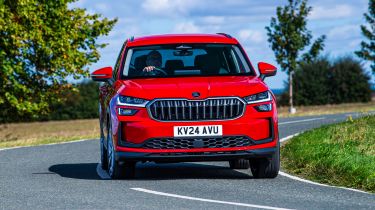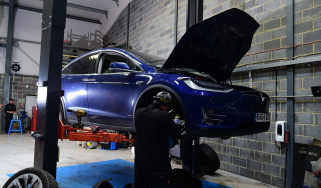Skoda Kodiaq - Engines, performance & drive
The Skoda Kodiaq isn’t the most dynamic SUV, but it is comfortable, and the engine lineup is strong

While some rivals are embracing hybrid drive, the Skoda Kodiaq is more cautious with its electrification options. The entry point to the range is the 148bhp 1.5 TSI four-cylinder petrol, which has mild-hybrid assistance and a cylinder-deactivation system that cuts in under light throttle loads. Performance from this unit is adequate, with a quoted 0-62mph time of 9.7 seconds, or 9.9 seconds for the seven-seat version. A seven-speed DSG twin-clutch gearbox is fitted as standard, as is front-wheel drive.
The 2.0 TDI diesel is available in two power outputs, with 148bhp and front-wheel drive, or 190bhp and four-wheel drive. The former has a 0-62mph time of 9.6 seconds (or 9.8 seconds for the seven-seater), while the more powerful car manages the sprint in eight seconds exactly. Both come with the same seven-speed twin-clutch auto as the 1.5 TSI.
The Kodiaq iV plug-in hybrid makes 201bhp and offers a 0-62mph time of 8.4 seconds. It’s front-wheel drive and is fitted with a six-speed automatic gearbox.
Anyone planning on taking their Kodiaq off-road should specify the Rough Roads Package, which gives you extra underbody protection to shield vulnerable parts from rocky terrain. If you just need a car to get you down a muddy farm track, we found the two-wheel drive version still coped perfectly well.
| Model | Power | 0-62mph | Top speed |
| Kodiaq 1.5 MHEV petrol (seven-seats) | 148bhp | 9.9s | 127mph |
| Kodiaq 2.0 TDI 193 4x4 | 190bhp | 9.0s | 134mph |
| Kodiaq 2.0 TDI 150 | 148bhp | 9.6s | 127mph |
What is the Skoda Kodiaq like to drive?
The VW Group’s MQB platform features beneath the Kodiaq’s large body, but while the same architecture is used for some sharp-handling hot hatchbacks, the Skoda is geared towards comfort.
In town
All of the engines offered in the Kodiaq respond strongly from low revs, so you don’t have to work them too hard to get this large SUV going.
Used - available now

2019 Skoda
Kodiaq
61,774 milesManualPetrol1.5L
Cash £15,303
2021 Skoda
Kodiaq
30,597 milesAutomaticPetrol1.5L
Cash £21,450
2021 Skoda
Kodiaq
65,898 milesAutomaticDiesel2.0L
Cash £23,703
2021 Skoda
Kodiaq
67,506 milesManualPetrol1.5L
Cash £16,288Front and rear parking sensors and a reversing camera are fitted as standard to all models, while light steering and controls mean positioning the car is relatively easy.
On A- and B-roads
At higher speeds, the Kodiaq delivers decent comfort, although the ride can become a little fidgety over minor bumps and undulations. This is an issue that’s amplified on cars that are fitted with the larger 19 and 20-inch wheel options (18-inch wheels are standard on SE models).
While there’s fidgeting, the overall set-up is soft, so there’s body roll in corners, but it’s not as severe as you’ll experience in some rivals, because the Kodiaq has a relatively low kerbweight for a seven-seat SUV. The light steering doesn’t give much in the way of feedback, but the Skoda feels more like a large hatchback to drive than a big 4x4, and for many people that will help to inspire confidence that they can manage this SUV.
On the motorway
At smaller throttle openings the Kodiaq’s twin-clutch gearbox short-shifts to help fuel efficiency, but when you’re accelerating harder, there’s more noise to be heard. The 1.5 TSI isn’t bad, but the 2.0 TDI can get a bit raucous when pushed.
Thankfully things settle down once you’re up to speed, and the Skoda is a comfortable cruiser on the motorway, with minimal road and wind noise to be heard. Skoda’s cylinder-deactivation system is imperceptible in its operation – the only clue that it’s working is a small icon that appears within the dials.
Engines, 0-60 acceleration and top speed
There are four engine options available in the Skoda Kodiaq, kicking off with the 1.5 TSI e-TEC 150, which makes 148bhp and 250Nm of torque and sends drive to the front wheels via a seven-speed twin-clutch gearbox. In SE form this engine delivers a 0-62mph time of 9.7 seconds and a top speed of 128mph, although the seven-seat version has a 0-62mph time of 9.9 seconds and a 127mph top speed.
The 2.0 TDI 150 matches the 1.5 TSI’s power output of 148bhp, has 360Nm of torque and is also front-wheel drive with a seven-speed DSG auto. It has a 0-62mph time of 9.6 seconds and a 127mph top speed in five-seat guise, while the seven-seater manages 0-62mph in 9.8 seconds and has a top speed of 126mph.
Choose the more powerful 2.0 TDI 193 that comes with four-wheel drive, and the power is increased to 190bhp plus there’s 400Nm of torque. All cars with this set-up have seven seats, and the official 0-62mph time is 8.0 seconds, with a top speed of 134mph.
The five-seat Kodiaq iV plug-in hybrid is the most powerful version of the Kodiaq at the moment (a vRS is said to be in the pipeline), with 201bhp, although torque isn’t as strong as the diesels, at 250Nm. The extra weight of the hybrid system blunts its performance, although it’s still capable of 0-62mph in 8.4 seconds on the way to a top speed of 130mph.








